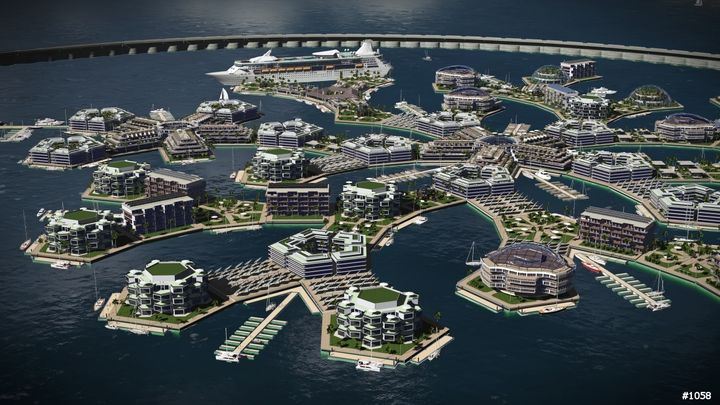Rising sea levels are the dangerous result of global warming that necessitates the implementation of costly projects that aim at saving millions of homes and lives. Floating cities are usually considered to be among the options thoroughly researched by scientists. Such constructions might be able to provide an alternate livable place in case land has been lost or is at risk of being flooded. Thus, at this moment, floating cities might be the solution to rising sea levels due to their sustainability and socio-economic benefits.
Rising sea levels affect coastal populations by flooding the area and forcing people to flee to other countries to save their lives and find refuge. According to Crew (2017), low-lying Pacific islands, such as Kiribati and regions of French Polynesia, are especially at risk of vanishing due to such issues. Consequently, as seen in Figure 1, floating cities might be considered safer and more sustainable (Carli, 2016b). An executive director of Seasteading Institute, Randolph Hencken, argues that creating such cities is one feasible approach for these locations to productive, robust land on which the possibility to survive and thrive is much higher (Crew, 2017). Moreover, such a strategy can protect the local population that resides in islands such as Tahiti from escaping their sinking residences in the upcoming years. Still, it would also provide a “unique tourist experience to help bolster them economically” (Carli, 2016a, para.8). A new industry of floating islands will encourage individuals to remain connected to their country rather than migrate to other nations (Carli, 2016a). This is the perspective that captivated the attention of French Polynesia. This is why the authorities permitted the development of a prototype that can be duplicated while being integrated into the local economy and supply chain.
As for the cost of living in such constructed cities, Hencken was candid. According to the executive director, it will not be affordable to live in such cities at first. He further proceeds that the basic interconnected floating platforms that are able to accommodate 20 to 30 people are projected to cost around $15 million (Crew, 2017). As a result, because 20% of every platform is allotted for open area, it is estimated that a habitable area will cost $504 per square foot, which is less than current costs in Central London or Manhattan (Crew, 2017). However, Hencken believes that rates will decrease as more individuals relocate to the floating cities, and additional platforms will be created. He stated that in order to convince people to relocate to the floating area, the research group must provide a convincing use case in order for the society to produce economic activity and promote growth (Crew, 2017). In this case, among the advantages that such cities might offer are Internet-based enterprises and serve as a tourist attraction, boosting economic growth. Moreover, such platforms might operate as aquaculture stations.
As a result, the articles provide hope for populations who reside in unsafe regions. According to the information in the materials, floating cities are, in fact, the solution to rising sea levels. There are many reasons why authorities choose to implement such innovative plans. Among the most enticing factors are the benefits that stem from increased tourism and the ability to incorporate new industries, such as aquaculture, sustainability, and protection. Though it might be costly at first, when more people relocate, the accommodation in floating cities might become affordable.
Hence, global warming is an immense challenge in today’s society. The results of such an issue are the rising sea levels that make many communities flee their homes, seeking safety from flooding. Consequently, while some entrepreneurs invest in space exploration and the possibility of moving to other planets, other individuals propose faster and cheaper ways to protect the community. Thus, it can be seen that floating cities are becoming the new reality that is able to protect vulnerable regions.

References
Carli, J. (2016a). Oceantop living in a Seastead. HuffPost.
Carli, J. (2016b). One proposed design for a Seastead [Photograph]. HuffPost.
Crew, B. (2017). French Polynesia just revealed plans to develop the world’s first floating city. ScienceAlert.